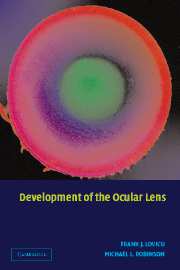6 - Lens Cell Membranes
Published online by Cambridge University Press: 30 January 2010
Summary
Introduction
The transparency of the lens is closely linked to the structure and function of its cell membranes. To minimize light scattering, lens fiber cells are packed together in a tightly ordered array so that the space between the cells is smaller than the wavelength of light. Achievement of this configuration requires cell membranes to have sets of proteins able to facilitate the formation of junctions between cells, while its maintenance requires the effective regulation of cell volume. For a long time, much of the work on lens membranes was primarily devoted to the identification and biochemical characterization of intrinsic and peripheral membrane proteins and of the membrane lipids in which they are embedded. The main emphasis of this early work was on how these molecules were modified during lens aging and cataractogenesis, often without knowledge of their functions. It is only in the last 10 years that significant progress has been made on the important contributions cell membranes and their embedded proteins make to the physiology of the lens. The greatest quantum step in this context has without doubt been the discovery that the lens generates a circulating current (Robinson and Patterson, 1983). This current is believed to generate a circulating flux of ions and water that percolates through the lens carrying nutrients deeper into the lens and returning waste products to the lens surface more efficiently than is conceivable by passive diffusion alone (Mathias et al., 1997).
Information
- Type
- Chapter
- Information
- Development of the Ocular Lens , pp. 151 - 172Publisher: Cambridge University PressPrint publication year: 2004
Accessibility standard: Unknown
Why this information is here
This section outlines the accessibility features of this content - including support for screen readers, full keyboard navigation and high-contrast display options. This may not be relevant for you.Accessibility Information
- 1
- Cited by
